#baltic centre for contemporary art
Explore tagged Tumblr posts
Photo








For Hew Locke’s exhibition, Listening to the Land, at P.P.O.W. he has created intricate sculptures and paintings that are fascinating in person.
From the press release-
Locke is known for exploring the languages of colonial and post-colonial power, and the symbols through which different cultures assume and assert identity. Furthering the themes explored in his celebrated commission The Procession at Tate Britain, and his concurrent installation Gilt on the façade of The Metropolitan Museum of Art, this exhibit engages with contemporary and historical inequities while reflecting on the landscape and history of the Caribbean. The exhibition draws its title from a poem by Guyanese political activist and poet Martin Carter which situates itself between two opposing forces of the landscape – sea and forest. Locke’s show features new sculptures and wall works with recurring motifs of stilt-houses, boats, memento mori, and share certificates referencing tensions between the land, the sea, and economic power. Reflecting on these links, Locke notes, “The land was created to generate money for colonial power, now the sea wants it back.”
Translating to ‘land of many waters,’ Guyana and its physical, economic, and political landscape serve as one of the primary sources for Locke’s work. Having spent his childhood in this newly independent nation, the artist witnessed first-hand an era of radical transformation. Now, the country teeters on the precipice of an oil boom and is one of the world’s fastest growing economies. Juxtaposing personal meditations on the climate crisis with political commentary on the history of a globalized world, Locke contemplates the ways in which colonies were exploited to accumulate capital, and observes how Guyana’s economic future lies in the exploitation of its waters. Locke’s new boat sculptures The Relic and The Survivor embody this broad worldview as the two battered wrecks drift through time and history. Evoking the fragmented and diverse legacies of the global diaspora, the boats’ patchwork sails are interspersed with photo transfers of 19th Century cane cutters and banana boat loaders, while their decks are loaded with cargo that could allude to colonial plunder, trade goods or personal belongings.
Based on an abandoned plantation house, Locke’s newest sculpture Jumbie House 2 features layered images that unveil the spirits that haunt this colonial vestige. Presented alongside are a series of painted photographs of dilapidated vernacular architecture across Georgetown and rural Guyana. Constantly under threat of being washed away by storms or rising sea levels, these crumbling structures echo anxieties surrounding climate change and historical erasure. A new series of mixed media wall works, Raw Materials, is derived from antique share certificates and bonds. Locke richly decorates the appliques with acrylic, beads, and patchwork to draw attention to the complex ways in which the past shapes the present. The image of an 1898 Chinese Imperial Gold Loan behind painted Congolese figures connects the global economy at the height of Empire to current Sino-African trade networks. In another work, a painted representation of a Nigerian Ife mask, alongside an image of David Livingstone, is layered on a French-African Mortgage Bond from 1923, connecting exploration and exploitation of African land, to current conversations surrounding the repatriation of artifacts. Taken together, the works in Locke’s Listening to the Land echo William Faulkner’s adage “The past is never dead. It’s not even past.”
This exhibition closes 4/1/23.
The Procession, mentioned above, can now be seen at Baltic Centre for Contemporary Art, in Gateshead, England until June 11th, 2023.
Gilt, also mentioned above, is on view at The Metropolitan Museum of Art until May 30th, 2023.
#hew locke#p.p.o.w#p.p.o.w gallery nyc#nyc art shows#sculpture#art installation#painting#guyana#baltic centre for contemporary art#the met#the metropolitan museum of art#uk art shows#art#art shows#models#photography#england art shows#gateshead#newcastle
15 notes
·
View notes
Text



The Duke of Cambridge attended a reception at the Baltic Centre for Contemporary Art during a visit to The Great Exhibition Of The North in Gateshead || 7 SEPTEMBER 2018
#prince of wales#the prince of wales#prince william#will cambridge#british royal family#british royals#royalty#royals#brf#royal#british royalty#royaltyedit#royalty edit#7092019#GrtExhibitOfNorth19#great exhibition of the north 19#duke of cambridge
26 notes
·
View notes
Photo

Evita Vasiljeva
Baltic Triennial 14: The Endless Frontier
Contemporary Art Centre (CAC), Vilnius, Lithuania
June 4 – September 5, 2021
69 notes
·
View notes
Text

7 September 2018 | Prince William, Duke of Cambridge attends a reception at the Baltic Centre for Contemporary Art as he visits The Great Exhibition Of The North in Gateshead, England. The reception was held to celebrate and acknowledge all those who have been involved in making the Great Exhibition happen. During the visit Prince William also visited the Sage international music centre, PROTO which is an emerging Technology Centre and Ryder Architecture Cooper’s Studios. The Great Exhibition of the North is a three-month celebration of the North of England’s pioneering spirit and draws to a close this weekend. Showcasing great art and culture, design and innovation across the North, the Exhibition tells the story of the North of England and how its innovators, businesses, artists and designers have shaped the region in the present and how they are inspiring the future. (c) Ian Forsyth - WPA Pool/Getty Images
2 notes
·
View notes
Text
Lorna Simpson
Guarded Conditions, 1989

Lorna Simpson makes conceptual photographs and collages that explore issues of representation, identity, and history as they relate to the African American female experience. She combines original, found, or archival images with snippets of text, washes of paint, and collaged elements. Simpson often works in series and with gridded formats as she simultaneously generates meaning and mystery; she often shows her subjects from behind or obscured, which further rejects simple narrative resolutions. Simpson has been the subject of solo shows at the Museum of Modern Art, the Brooklyn Museum, the Museum of Contemporary Art Chicago, and the BALTIC Centre for Contemporary Art, among other institutions. She featured at the Venice Biennale in 1990 and 2015, at Documenta in 1987 and 2002, and at the Whitney Biennial in 1993, 1995, and 2002. On the secondary market, Simpson’s work has sold for up to six figures. Her practice has also encompassed film.
1 note
·
View note
Text

BALTIC: NEWCASTLE UPON TYNE
I was invited by artists Neil Bromwich and Zoe Walker to perform a piece entitled ‘The Secret Life of Plants’ at Baltic Centre for Contemporary Arts. This was for their show, ’The Encampment of Eternal Hope.’ which coincided with the summer solstice. For this I installed a number of large inflatable plants in the exhibition space whilst singing Stevie Wonder’s song ‘The Secret Life of Plants’. This song is lifted from a concept album inspired by the book and film ‘The Secret Life of Plants’ by Peter Tomkins and Christopher Bird, which explores the physical, emotional, and spiritual relations between plants and man.
0 notes
Text
MYRIAM VAN IMSCHOOT AND MAT POGO AT THE SURVIVAL KIT FESTIVAL

2024/09/28-29 Survival Kit NATURE Workshop by MYRIAM VAN IMSCHOOT and MAT POGO Gallery Smilga Riga - LV
Myriam van Imschoot and Mat Pogo were invited to hold a workshop for 'Nature', the third episode of four in this year's 15th edition of the Survival Kit Contemporary Art Festival in Riga, organised by the Latvian Centre for Contemporary Art. The workshop will take place over two days, Saturday and Sunday 28 and 29 September Check the programme here For the 15th time this autumn the Latvian Centre for Contemporary Art will host the Survival Kit festival in Riga - one of the most notable annual contemporary art events in the Baltics. The exhibition "Measures", curated by the festival's artistic director Jussi Koitela, will be open from 6 September to 6 October at three locations on both banks of the River Daugava - 4 Amatu Street, 34a E. Smiļģa Street and 4 Strazdu Street. As every year, the festival will be accompanied by an extensive public and educational programme, keeping in mind the accessibility of contemporary art to different groups of society. A separate programme of events will also take place within the framework of the contemporary culture forum "White Night".Continuing the theme of the exhibition "Measures", the public programme of the festival invites artists and thinkers to reflect on the different forms of knowledge produced by the city and its communities. Gundega Laiviņa, curator of the Survival Kit 15 public programme, says: "The programme is designed to remind people of their right to access the city's resources, their right to change the city and to change themselves. It invites us to see the city not as a fixed and finished environment to navigate, but rather as a porous and ever-changing space where things become possible."
The Survival Kit 15 public programme, curated by Gundega Laiviņa, is divided into four episodes - "Artist" (11 September), "Place" (21 September), "Nature" (29 September) and "Future" (5 October) - held at all festival's exhibition addresses and throughout Riga.
The third episode of the public programme, "Nature", will reveal the inextricable, complex relationship between the city and nature in the form of a collective ritual - two chirping sessions led by the Flemish artist Myriam van Imschoot. https://lcca.lv/en/events/survival-kit-15-programme-announced/
THE THIRD EPISODE: NATURE Saturday, September 28 18.00-21.00 Sunday, September 29, 6.30-9.30 Meeting place: Gallery Smilga at Eduarda Smiļģa street 34a In our consciousness and communication, the city and the country seem to be two separate spaces. The third episode of the public programme will break down this invisible boundary and reveal the inextricable, complex, and fluid relationship between the city and nature.
The episode will focus on the idea of the city as a habitat for diverse organisms and communities. How to build a city that respects every being, and its right to space and life? Who is destined and allowed to survive in the city? The answer to this question will be sought not in theory, but in a collective ritual - in two cricketing sessions, during which the voice and the body will be used to get closer to the knowledge of more-than-humans. We will gather at sunrise and sunset to listen to the city and gradually become a choir of grasshoppers, cicadas, crickets, and locusts.
The sessions will be led by Berlin-based improviser and producer Mat Pogo and Myriam van Imschoot, a Flemish artist who works with sound, exploring yodelling, crying, nature sounds and new polyphonies created by the fusion of human and more-than-human sounds, with the city humming in the background.
In this session we will develop a particular sounding and listening practice that Myriam Van Imschoot developed over the last ten year based on studies of sonic ecology and biomimicry. Inspired by the stridulation of insects (the rubbing of wings and other body parts), the artists developed a set of techniques for humans to ‘chorus’ together like insects. Cricketing proposes to practice as a ‘sonic community’ the subtleties of vibrational listening, the complexities of rhythmical pulsations and the pleasure of diving in and out of noise within an environmental dialogue with nature. The overall collective composition emerges from the many small interactions that happen on site amongst the participants. The Session encompasses warm-ups, listening moments, cricket practice and improvisational scores.
Open for anyone who is a nature lover, a keen listener, a person who loves sound or has a curiosity for new sound techniques. Enlist by sending your prefered Session time, a couple of sentences about yourself and how this Session speaks to you to the e-mail: [email protected].
Depending on the weather conditions the Session will happen outdoors or as a mixture of indoor and outdoor moments. Participants will be guided in English. https://lcca.lv/en/survival-kit-15/programme-sk15/
0 notes
Text
ESTONIAN MUSEUM'S

KUMU
The aim of the Kumu Art Museum, opened in 2006, is to preserve and interpret Estonian art from the 18th century to the present day.
Kumu views its role as being an initiator of a social and cultural debate in connection with both expositions of art history and events in the Gallery of Contemporary Art, which has become an incubator for new ideas for domestic and foreign artists. Besides preservation, important tasks of the museum include displaying the works of art in its collections to initiate debates on their meaning and to shape various interpretative environments. In the fifteen years before Kumu was opened, people did not have constant access to the classics of Estonian art and the permanent display of Soviet art only became possible once Kumu opened.
In 2008, the Kumu Art Museum received the European Museum of the Year Award from the European Museum Forum.

The idea of constructing a special building for the art museum was conceived in the 1930s, and a few architectural contests were held. The project that won in 1936 was never realised as World War II broke out. After Estonia had regained its independence, the construction of the new main building for the Art Museum of Estonia was revisited. In 1993, an international architectural contest was organised, with architects from ten countries participating with a total of 233 projects. The winner of the contest was the design by the Finnish architect Pekka Vapaavuori. The construction began in 2002 and the completed museum opened its doors to the public on 18 February 2006.

The Kumu Art Museum fulfils the functions of a national gallery and a museum of contemporary art. The exposition is spread out on different floors, leading visitors from older art to more recent works.
The exposition starts on the third floor, where you will see the Baltic German artistic heritage from the 18th and 19th centuries and an overview of Estonian national art from the first half of the 20th century. On the fourth floor, the display continues with Soviet Estonian art and the art of the 1990s. The permanent exhibitions also include several project spaces meant for the in-depth study of issues, artists or phenomena of certain eras. The fifth floor of the Kumu building houses the Gallery of Contemporary Art, where new exhibitions are held on a regular basis.
Besides the contemporary art gallery, the most important space for temporary exhibitions is the Great Hall on the ground floor of the museum, which can be accessed from the atrium near the ticket counter. In the Great Hall, we exhibit the most extensive and complicated research projects and foreign expositions, which require a high level of collaboration with various institutions around the world.
Annually, Kumu holds eight to ten major temporary exhibitions of both historical and contemporary art from Estonia and abroad. Kumu has also chosen a few topics to concentrate on in research and exhibition projects. Some of the main themes are Estonian art in the early 20th century, the avant-garde artists of the Soviet era, sound art, fashion, visual studies and female artists.
Kumu’s permanent exposition and temporary exhibitions are mediated to the audience by the Kumu Education Centre, which manages the museum’s busy programme of public talks, discussions, tours, activities for schools and the operation of art studios.
1 note
·
View note
Text
Baltic Centre For Contemporary Arts, LGBTQ United Methodist Church, Roblox, More: Tuesday Afternoon ResearchBuzz, September 3, 2024
NEW RESOURCES NARC: News: Baltic Centre For Contemporary Arts – Online Archive. “Baltic Centre for Contemporary Art in Gateshead has launched a new online archive chronicling 25 years of contemporary art exhibitions and learning and engagement projects at the gallery. The expansive archive features more than 30,000 individual items from the Baltic’s programming history and onsite library,…
0 notes
Text
Frankie Raffles: Photography, Activism, Campaign Works
Baltic Centre for Contemporary Art – Ends 16 March 2025 – Free Franki Raffles Exhibition at Baltic – Picture: Photo By Amey A short history of Franki Raffles and her life in retrospective Franki Raffles (1955-1994) contributed a lot to both the field of photography and to female art during her relatively short lifetime; she passed away during childbirth aged just 39. Her career emerged in the…
#Baltic#Exhibition#feminist#femminism#franki raffles#gateshead#international#Newcastle#photography#retrospective#review#scottish#women
0 notes
Text

July 6, 2024. We went to the Baltic in Gateshead to look at art. There were kittiwake chicks. https://www.tynekittiwakes.org.uk/tyne-kittiwake-colonies/baltic-centre-for-contemporary-art-kittiwakes/
1 note
·
View note
Photo

Tekla Aslanishvili, Scenes from Trial and Error, 2020
Baltic Triennial 14: The Endless Frontier
Contemporary Art Centre (CAC), Vilnius, Lithuania
June 4 – September 5, 2021
45 notes
·
View notes
Text
Exploring Newcastle: The Ideal Destination for Your UK Study Adventure
If you're considering studying in the UK, Newcastle should be high on your list. This vibrant city offers a perfect blend of academic excellence, rich culture, and an engaging student life. For those seeking guidance on this exciting journey, partnering with a consultancy for abroad studies in Pune can streamline the process and ensure you make the most informed decisions.
Academic Excellence
Newcastle is home to two prestigious universities: Newcastle University and Northumbria University. Both institutions are renowned for their research capabilities, high teaching standards, and diverse range of courses. Whether you're interested in engineering, business, medicine, or the arts, you'll find top-notch programs designed to equip you with the skills needed for a successful career.
Rich Cultural Experience
One of the most appealing aspects of studying in Newcastle is its rich cultural heritage. The city boasts a plethora of museums, galleries, and historical sites. The BALTIC Centre for Contemporary Art and the Great North Museum are just a few examples of the cultural treasures awaiting you. The city's history is vividly displayed in its architecture, from the mediaeval Newcastle Castle to the iconic Tyne Bridge.
Vibrant Student Life
Newcastle is famous for its lively student scene. With a wide range of cafes, bars, and clubs, there's always something happening in this dynamic city. The Ouseburn Valley is a particularly popular area among students, known for its trendy pubs and vibrant music scene. Additionally, the city's numerous parks and the nearby Northumberland countryside offer excellent opportunities for outdoor activities and relaxation.
Support for International Students
Navigating the complexities of studying abroad can be daunting. This is where a consultancy for abroad studies in Pune can be invaluable. These experts can help you with everything from choosing the right university and course to handling visa applications and accommodation arrangements. Their local knowledge and experience ensure that you have all the support you need to make your transition to Newcastle smooth and stress-free.
Conclusion
Newcastle is an excellent destination for international students, offering top-tier education, a rich cultural experience, and a welcoming environment. By working with a consultancy for abroad studies in Pune, you can embark on your UK study adventure with confidence, knowing you have expert guidance every step of the way.
0 notes
Text

Construction Fencing, Taxi; Manhattan, NYC, 2023 Polaroid SLR 680 with Polaroid 600 colour film
This photo is currently on display at Baltic Centre For Contemporary Art, Gateshead, as part of their Baltic Open Submission 2024 show. It's open now and on display until 1st September.
#polaroid#photography#my photography#analogue photography#polaroid slr 680#manhattan#nyc#new york#abstract photography
1 note
·
View note
Text

Identity for 'Climate Frequencies' podcast series Baltic Centre for Contemporary Art, Gateshead 2021
0 notes
Photo
PAKUI HARDWARE BIOGRAPHY
Pakui Hardware is the name for the collaborative artist duo Neringa Cerniauskaite and Ugnius Gelguda which began in 2014. Their latest solo shows include Underbelly, Museum der bildenden Künste Leipzig (MdbK), Germany; Thrivers, Polansky gallery, Prague (both 2019); Extrakorporal, Bielefelder Kunstverein, Germany; The Return of Sweetness, Tenderpixel gallery, London (both 2018); Creatures of Habit, Trafó Gallery, Budapest; SIC, Helsinki, and Artissima, Turin, IT; On Demand, EXILE, Berlin (all 2017); Vanilla Eyes, MUMOK, Vienna (2016); Lost Heritage, Kim?, Contemporary Art Centre, Riga (2015); The Metaphysics of the Runner, Contemporary Art Centre (CAC), Vilnius and 321 Gallery, Brooklyn, New York (both 2014). Among many others the artists participated in group shows at 16th Istanbul Biennale; Kunsthalle Basel, CH; Ujazdowski Castle Centre for Contemporary Art, Warsaw; Musée d'Orsay, Paris; BOZAR, Brussels; MAXXI, Rome; 13th Baltic Triennial at Contemporary Art Centre, Vilnius; CCA Tel-Aviv; SALTS, Basel, CH; 20th Contemporary Art Festival Sesc_Videobrasil, Sao Paulo, BR; Kunstverein Brauschweig and Kunstverein Freiburg, DE; Domaine Pommery, FR; National Gallery of Art, Vilnius. Upcoming projects include solo exhibitions at Baltic Centre for Contemporary Art, Gateshead, UK; carlier | gebauer gallery, Berlin, and Leopold-Hoesch-Museum Düren, Germany.
Ugnius Gelguda is an artist based in Vilnius and Berlin.
Neringa Cerniauskaite is an artist, curator, writer. She contributes texts for exhibitions’ catalogues and international magazines (Artforum, Flash Art, Parkett, ARTMargins.com, MAP, Mousse magazine). She is an editor of the web-based art magazine www.artnews.lt that was launched in 2008. She is a M.A. graduate, 2014, at Bard College Center for Curatorial Studies, NY.
Both artists are based in Berlin and Vilnius.

Pakui Hardware, Thrivers, solo show at Polansky Gallery, Prague, 2019
http://www.pakuihardware.org/index.php?/ugnius-gelguda-with-neringa-cerniauskaite/thrivers-polansky-gallery-prague/
THRIVERS is the first solo show of Pakui Hardware duo in Czech Republic. Conceived specially for Polansky gallery space, the installation presents a setting for unresolved figures that merge human limbs with diverse bodies of extremophiles. Thriving under harsh environmental conditions such as extreme cold, heat, acidity or radiation, extremophiles are massaging us for the upcoming future scenarios.
Materials: glass, leather, silicone, chia seeds, metal stands, led lamps, polyurethane filter foam, propeller ceiling ventilator
20 notes
·
View notes